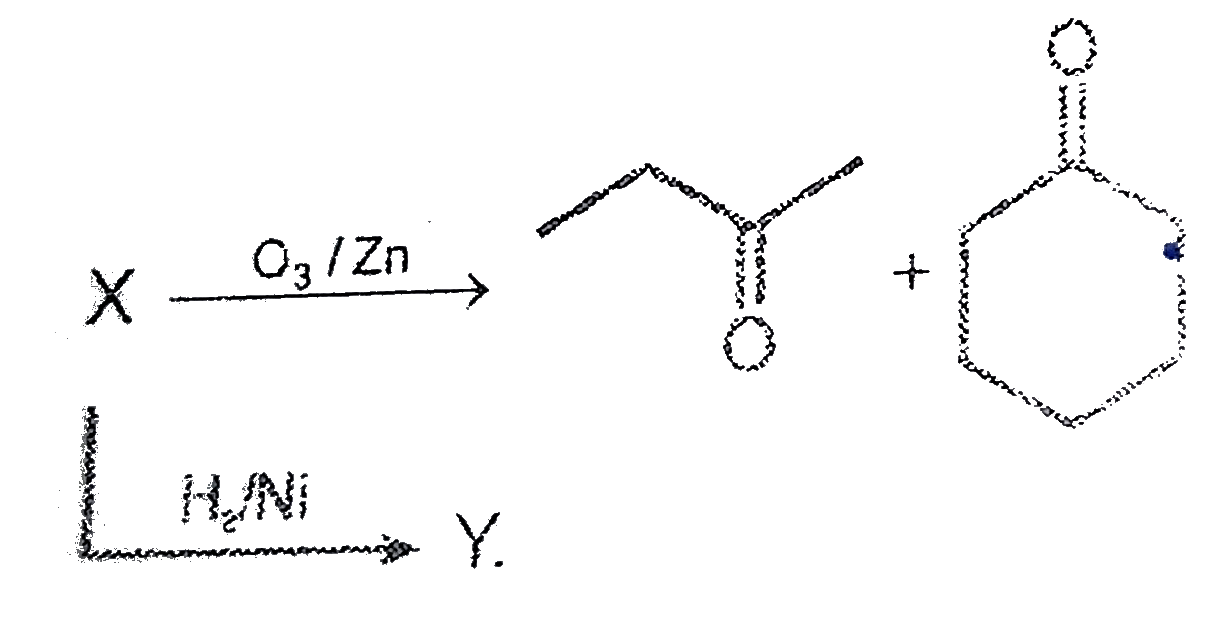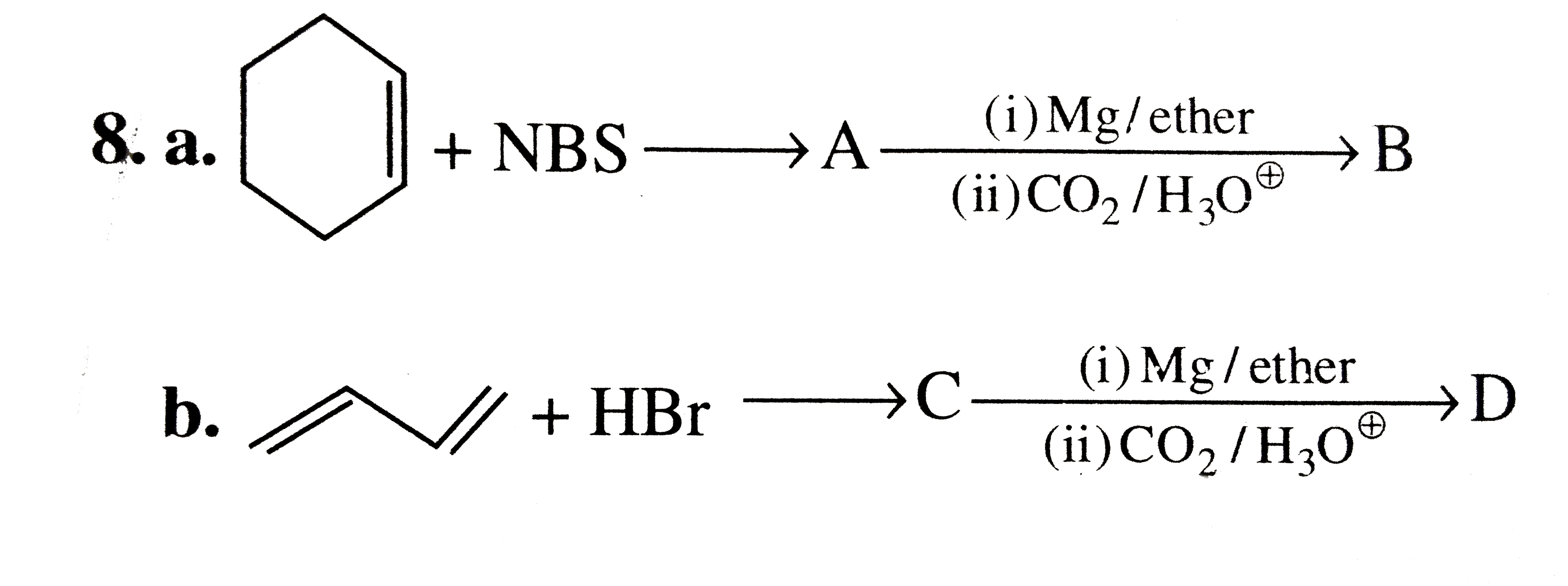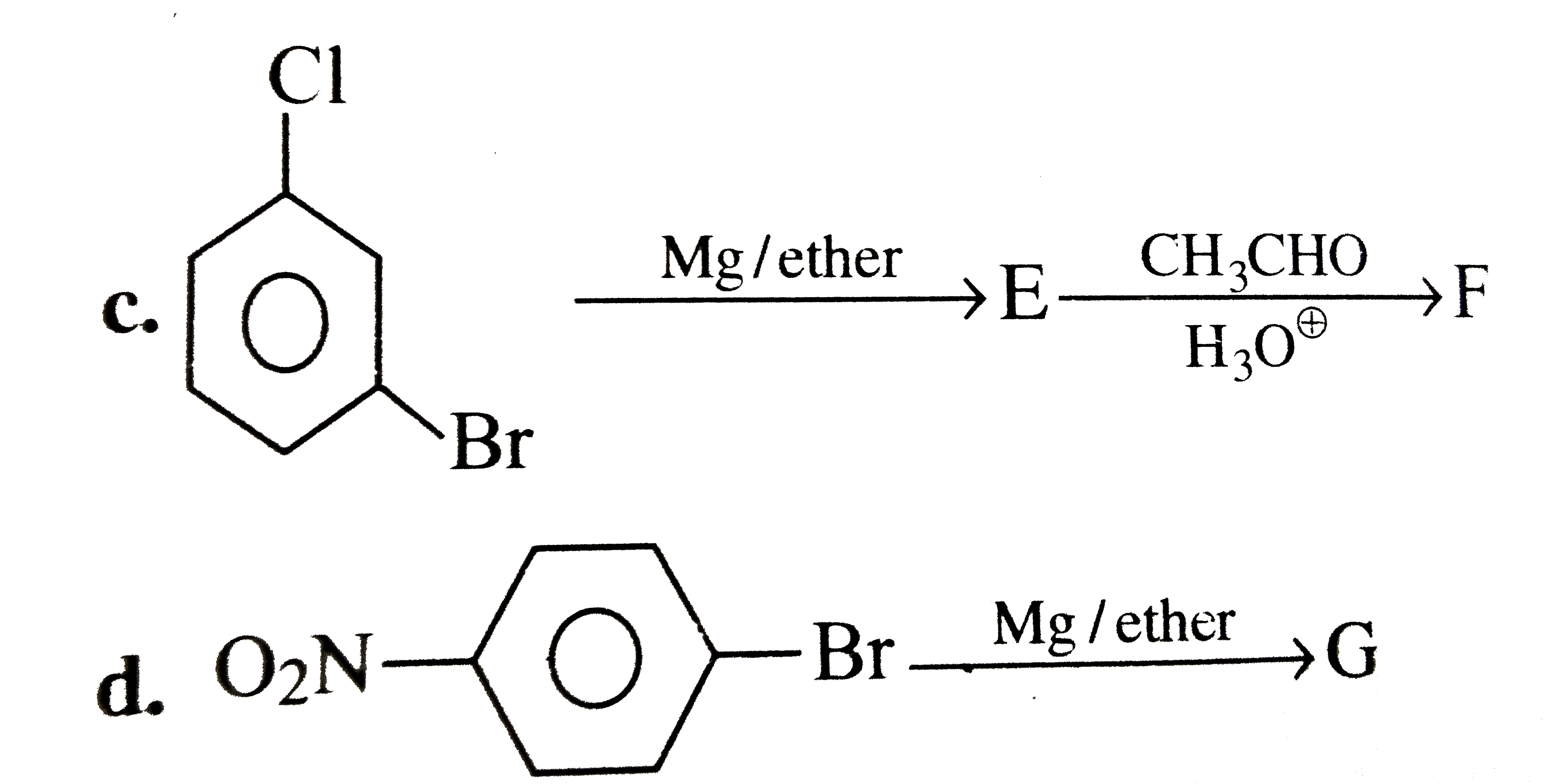Four isomeric optically active compounds NaHCO3−−−−−→CO2(g)(A,B,C,D)(C4H8O3)
Compound (A)LAH−−→(E) (Archiral compound)
Compound (B)KMnO4−−−−−→orCrO3 Inert to oxidation.
Compound (C)−−−−−−−−→NaOI/H3O⊕CHI3(Yellowppt.)+Compound(F).
Compound (C) is :
(I)
(II)
(III)
(IV)
The correct Answer is:B
To determine the structure of compound C based on the provided information, we will follow a systematic approach.
Step 1: Determine the molecular formula and degree of unsaturation
The molecular formula given is C₄H₈O₃.
To calculate the degree of unsaturation (DU), we use the formula:
\( \text{DU} = \frac{2 \times \text{number of Carbons} + 2 - \text{number of Hydrogens}}{2} \)
Substituting the values:
\( \text{DU} = \frac{2 \times 4 + 2 - 8}{2} = \frac{8 + 2 - 8}{2} = \frac{2}{2} = 1 \)
Step 2: Identify possible functional groups
A degree of unsaturation of 1 suggests the presence of either a double bond or a ring structure. Given the context of carboxylic acids and their derivatives, we can assume that compound C may contain a carboxylic acid group (–COOH) or an alcohol (–OH) group.
Step 3: Analyze the reactions of compounds A, B, and C
- Compound A reacts with LAH (Lithium Aluminium Hydride) to form an achiral compound E. This suggests that A likely contains a functional group that can be reduced, such as a carbonyl group (C=O).
- Compound B is inert to oxidation with KMnO₄, indicating that it likely does not have a hydrogen atom attached to a carbon adjacent to a carbonyl group (which would be oxidizable).
- Compound C reacts with NaOI/H₃O⁺ to yield CHI₃ (iodoform), which indicates that C must contain a methyl ketone or a secondary alcohol adjacent to a carbonyl group.
Step 4: Propose a structure for compound C
Given the above information, we can propose a structure for compound C. It should have:
- A carboxylic acid group (due to the molecular formula).
- A structure that allows for the formation of CHI₃ upon treatment with NaOI/H₃O⁺.
A possible structure for compound C could be:
- 3-hydroxybutanoic acid (or 2-hydroxybutanoic acid), which has the following structure:
CH3|CH|COOH∣CH2OH
Conclusion
Based on the analysis, compound C is likely to be 3-hydroxybutanoic acid (or 2-hydroxybutanoic acid), which fits the criteria of being optically active and capable of yielding CHI₃ upon treatment with NaOI/H₃O⁺.
The molecular formula given is C₄H₈O₃.
\( \text{DU} = \frac{2 \times \text{number of Carbons} + 2 - \text{number of Hydrogens}}{2} \)
\( \text{DU} = \frac{2 \times 4 + 2 - 8}{2} = \frac{8 + 2 - 8}{2} = \frac{2}{2} = 1 \)
A degree of unsaturation of 1 suggests the presence of either a double bond or a ring structure. Given the context of carboxylic acids and their derivatives, we can assume that compound C may contain a carboxylic acid group (–COOH) or an alcohol (–OH) group.
- Compound A reacts with LAH (Lithium Aluminium Hydride) to form an achiral compound E. This suggests that A likely contains a functional group that can be reduced, such as a carbonyl group (C=O).
- Compound B is inert to oxidation with KMnO₄, indicating that it likely does not have a hydrogen atom attached to a carbon adjacent to a carbonyl group (which would be oxidizable).
Given the above information, we can propose a structure for compound C. It should have:
- A carboxylic acid group (due to the molecular formula).
- A structure that allows for the formation of CHI₃ upon treatment with NaOI/H₃O⁺.
- 3-hydroxybutanoic acid (or 2-hydroxybutanoic acid), which has the following structure:
Based on the analysis, compound C is likely to be 3-hydroxybutanoic acid (or 2-hydroxybutanoic acid), which fits the criteria of being optically active and capable of yielding CHI₃ upon treatment with NaOI/H₃O⁺.
Topper's Solved these Questions
- CARBOXYLIC ACIDS AND THEIR DERIVATIVESBOOK - CENGAGE CHEMISTRY ENGLISHCHAPTER - CARBOXYLIC ACIDS AND THEIR DERIVATIVESEXERCISE - Exercises (Multiple Correct)
34 Videos
- CARBOXYLIC ACIDS AND THEIR DERIVATIVESBOOK - CENGAGE CHEMISTRY ENGLISHCHAPTER - CARBOXYLIC ACIDS AND THEIR DERIVATIVESEXERCISE - Exercises (Singlecorrect)
64 Videos
- CARBOXYLIC ACIDS AND THEIR DERIVATIVESBOOK - CENGAGE CHEMISTRY ENGLISHCHAPTER - CARBOXYLIC ACIDS AND THEIR DERIVATIVESEXERCISE - Exercises (Subjective)
19 Videos
- BIOMOLECULESBOOK - CENGAGE CHEMISTRY ENGLISHCHAPTER - BIOMOLECULESEXERCISE - Exercises Archives (Analytical And Descriptive)
8 Videos
- CHEMICAL KINETICSBOOK - CENGAGE CHEMISTRY ENGLISHCHAPTER - CHEMICAL KINETICSEXERCISE - Archives Subjective
23 Videos
Similar Questions
Knowledge Check
An optically active compound 'X' having molecular formula C4H8O3 . It evolves CO2 with NaHCO3. ' X 'on reaction with LiAlH4 give achiral compound. 'X' is:
A B
B C
C D
D
Compound (A)1molof−−−−−−→HIO4

The compound (A) is:
View SolutionCompound (A)(C6H8)[o]−−→ Malonic acid only. Identify compound (A).
View Solution (i)CH3CHO−−−−−−−→(ii)H3O+ (A) HBr−−→ (B)
(i)CH3CHO−−−−−−−→(ii)H3O+ (A) HBr−−→ (B)
The compounds (A) and (B)
View SolutionPhenyl isocyanide + Benzyl magnesium bromide 1.EtherΔ−−−−−→2.H3O⊕(A). The compound (A) is :
View SolutionXO3/Zn−−−→ ,

The IUPAC name of compound Y is :
View Solution(a)

(b)
( e) PhMgBrO2−−−→H3O⊕?
(f) Phenol+RMgI→?.
View SolutionC6H10NBS−−→(X)Mgether−−−−→(Y)CH3CN−−−−→H3O+(Z)
The compound (Z) is
View Solution
